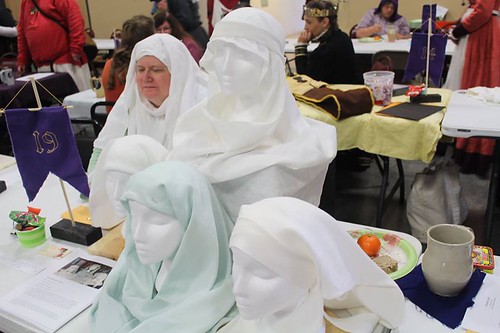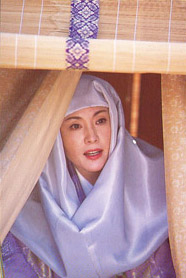
Me and my Zukin Examples, Queen’s Prize, Calontir, 2016. I’m actually wearing European garb in this photo, though! Photo credit: Vilhelm Lich.
So reenactment versus appropriation—where do we draw the line? I was a little surprised at my own reaction upon seeing a picture of some of the populace’s response for the recent coronation in Trimaris, because they were words used in the Mass. For those of you who don’t know me, I am Catholic. For the most part, I’m pretty liberal, but to see Mass responses from the populace to what I assume was a fake Archbishop (as most Archbishops I have met would be way too busy to have much to do with the SCA) for some reason twisted my gut. I’m not sure why. Heaven knows these phrases have often been co-opted by modern society for reasons of entertainment or protest or even mockery.
I think it bothered me because I actually really love participating in the ritual of the Mass. For me, Mass is a rich spiritual experience. It gives me the deep connection to God that I rarely felt during my Southern Baptist childhood. So it threw me off a bit to see these phrases co-opted for a Coronation.
Will I be baying for the blood of whoever had this bad idea? Probably not. My discomfort is my own issue that I will deal with. But it has made me take a hard look at the work I have been doing with my own persona, a Japanese noblewoman who has taken lay Buddhist vows. The lay Buddhist vows part came into play 10 years ago, when I first started researching zukin (literally “hood”, although it can mean “wimple” as well).
Medieval Japanese women tended to wear their hair long and uncovered, usually down or simply tied back. I have very short hair. I had issues with trying to wear a wig—my complexion doesn’t go well with black hair and wearing a colored wig with Japanese garb reeked of anime to me. So I found a solution—zukin. They are most often associated with Buddhist nuns, although later research showed that versions were worn by peasant women. Noble Japanese women would sometimes take “partial vows”, which had them living a religious life, but at home, not in community like a nun would. When these women took their vows, they would cut their hair, a deeply significant action in Japanese culture, and wear a zukin. They would wear their normal clothing otherwise, although they might also wear a kesa (a kind of surplice) as a sign of devotion.
So I thought, okay, I’ll just make my persona a lay Buddhist nun, a widow who had taken partial vows in her later years. I could wear my Japanese garb with the zukin and all would be well. I did sometimes wonder whether this was appropriation of some kind (usually a bad sign right there), but tried to counter that by studying about Japanese Buddhism, its practices and philosophies, and its impact on everyday culture. It’s been years, but I feel like I’ve barely scratched the surface in my research. This is a rich and incredible field of study.
But now, I’m definitely feeling guilty. I’m not Buddhist. Is it really respectful to be portraying someone who has taken sacred vows? Buddhism is still very much a living religion. Would a Buddhist seeing me at an event cringe the way I did when reading those words from the Trimaris coronation?
So I’m not sure what to do about this. Fortunately, I’m having to take a couple of months off anyway due to an upcoming surgery so there’s time to think about what I want to do going forward. I love my Japanese studies—the history, culture, literature, calligraphy, art. All of it! But I want to approach that from an area of respect.
Although, considering that I tend to wear European garb half the time, this may only be an issue between me and my conscience. I could keep my Japanese persona and just keeping wearing a variety of garb. It confuses people, but I’ve been doing that for years. But I am interested in wafuku (Japanese clothing), too.
